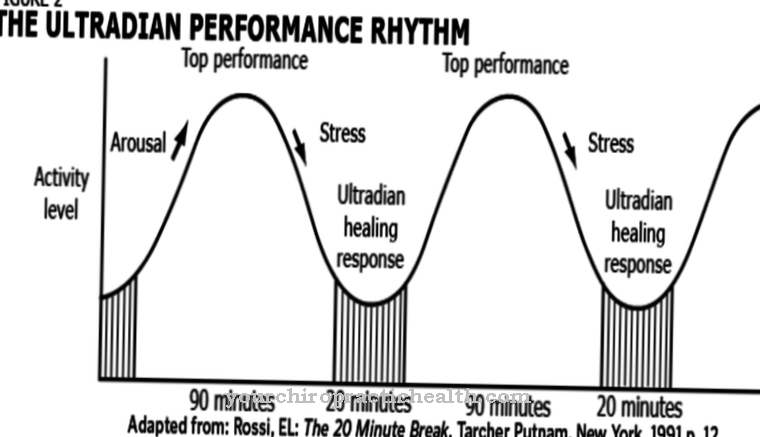The Refractory period is the phase in which the re-excitation of neurons is not possible after the arrival of an action potential. These refractory phases prevent the retrograde spread of excitation in the human body. In cardiology, there is a disorder of the refractory period, for example with phenomena such as ventricular fibrillation.
What is the refractory period?

Biology understands the refractory period or refractory phase to be the recovery time of depolarized neurons. This recovery time corresponds to the period in which no new action potential can be triggered on a nerve cell that has just been depolarized. The nerve cell cannot react again to a stimulus during the refractory period.
In connection with the refractory period of neurons, a distinction is made between the absolute and relative refractory periods, which are directly adjacent to one another. The triggering of an action potential is only limited during the relative refractory period, but not impossible. In the narrower sense, only the absolute refractory period and the associated impossibility of a new action potential is to be understood as the actual refractory period.
Outside of medicine, the refractory period plays a role primarily with regard to stimulus-reactive aggregates and, in this context, meets the medical definition.
In cardiology, the refractory period can also mean another connection. Pacemakers are not allowed to stimulate themselves and must support the natural rhythm of the heartbeat that is still present. For this purpose, the signal recognition in pacemakers is deactivated for defined periods of time. These periods of deactivation are also refractory periods from a cardiological point of view.
Function & task
Nerve cells react to excitation by generating action potentials. This generation takes place through complex biochemical and bioelectrical processes in the constriction rings of the neurons. The action potential is passed on from ring to ring and accordingly jumps along the nerve pathways. This process is described with the term saltatory excitation conduction.
The transmission of an action potential depolarizes the membrane of the downstream neuron. When the membrane is depolarized beyond its resting potential, the neuron's voltage-dependent sodium channels open. Only the opening of these channels generates the action potential in the next neuron, which depolarizes the subsequent nerve cell.
After opening, the channels close automatically. After this process, they are not ready to be opened again for some time. The nerve cell must first let potassium ions flow out and thus repolarize its own membrane again below -50 mV.
Only this repolarization enables another depolarization. The sodium channels can therefore only be reactivated after repolarization is complete. Therefore, the cell can no longer respond to stimuli before complete repolarization.
During the absolute refractory period, no action potential can be triggered, regardless of the stimulus strength. During this time, all voltage-dependent channels are in an inactivated and closed state, which lasts around two ms. This phase is followed by the relative refractory period, during which some sodium channels have reached an activatable state again due to the repolarization that has started, although they are still closed. In this phase, action potentials can be triggered if there is a correspondingly high stimulus strength. Even then, the amplitude of the action potentials and the steepness of the depolarization are low.
The refractory period limits the maximum frequency of action potentials. In this way, the body prevents the retrograde spread of neuronal excitation. The refractory period protects the heart, for example, from an excessively rapid succession of contractions that could cause the cardiovascular system to collapse.
You can find your medication here
➔ Medicines for paresthesia and circulatory disordersIllnesses & ailments
Probably the best-known complaint in connection with the refractory period is ventricular fibrillation of the heart muscle. In contrast to skeletal muscles, failure to adhere to the refractory period for the heart muscle leads to life-threatening consequences. When electricity is passed into a skeletal muscle, it contracts. As the current increases, so does the contraction. A strong stimulus thus triggers an equally strong reaction in the skeletal muscles.
This relationship does not apply to the heart muscle. It only contracts when the stimulus is strong enough. If it is not strong enough, there will be no contraction. When the current is increased, the heartbeat does not get stronger at the same time and once a heartbeat has occurred there is a refractory period of 0.3 seconds. Skeletal muscles can therefore contract or be permanently tense in rapid succession, while the heart muscle is not able to do so.
During the refractory period, the chambers of the heart fill with blood. During the subsequent contraction this blood is ejected again. If the refractory period of the heart falls below the duration of around 0.3 seconds, then insufficient blood flows into the heart chambers. Accordingly, little blood is ejected again with the next heartbeat.
Shortly before the end of the refractory period, the muscle fibers of the cardiac conduction are already partially excited. If a stimulus reaches the heart muscle during this time, the heart responds with a racing heartbeat. Ventricular fibrillation sets in. The rapid heartbeat hardly moves any blood through the organism. A pulse can no longer be made out.
The refractory period of the heart also plays a role in relation to various medications. The class III antiarrhythmic amiodarone, for example, extends the refractory period of the ventricular and atrial myocardium.












.jpg)



.jpg)










.jpg)
